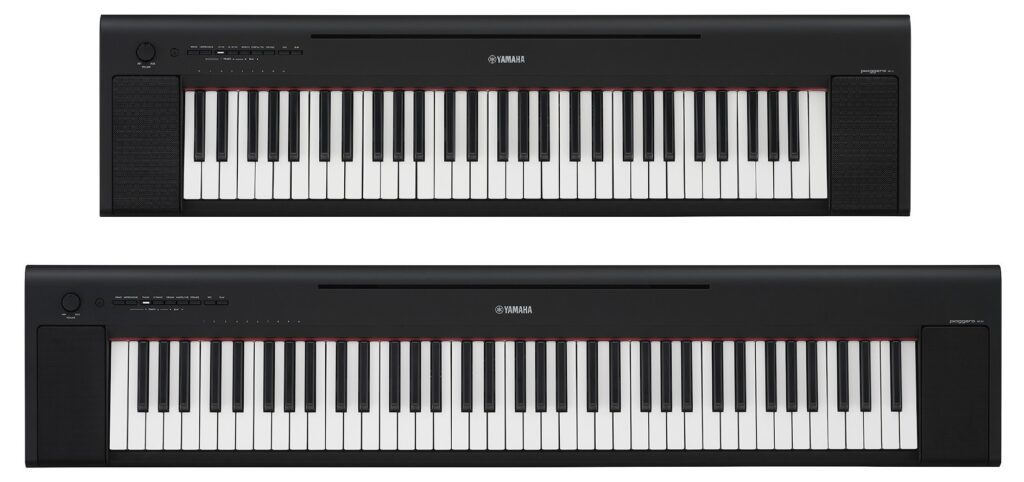The new Yamaha Piaggero digital pianos aren’t in the same sonic league as the Yamaha P-515, but they’re a lot easier to carry. The Yamaha Smart Pianist app supports both instruments.
NP-35 NP-15
----------------- -----------------
Keys 76 keys 61 keys
Action Graded soft touch Natural touch
Main piano CFIIIS CFIIIS
Tone gen AWM stereo AWM stereo
Polyphony 64 64
Tones 15 tones 15 tones
Reverb 6 types 6 types
Sound boost Yes Yes
Dual layer Yes Yes
MIDI record 1 track 1 track
Amplifier 2 x 6W 2 x 2.5W
Speakers 2 x (12cm x 8cm) 2 x (12cm x 8cm)
USB to HOST MIDI/audio MIDI/audio
Sustain pedal 1/4" jack 1/4" jack
Phones/OUTPUT 1/4" jack 1/4" jack
Batteries 6 x AA 6 x AA
Size (inches) 41.4W 4.1H 10.2D 49.6W 4.1H 10.2D
Weight 13.2 lb (6.0kg) 11.5 (5.2kg)
Two voices can be layered; no split. The keybed does double-duty playing notes and acting as a function button when METRONOME is held down. Hold METRONOME and DEMO together and you can adjust a whole slew of other things (tuning, transpose, audio loopback, etc.)
The NP-35 has a higher spec: Graded soft touch keys (vs. natural touch) and a more powerful 6W per side amplifier (vs. 2.5W per side). Yamaha describe “graded soft touch” as “heavier in the lower register and gradually lighter in touch as you go up to the higher register.”
Both instruments have the same tones: Concert Grand, Mellow Grand, Bright Grand, DX E.Piano, Stage E. Piano, Vintage E.Piano, Organ Principal, Organ Tutti, Jazz Organ, Harpsichord 8′, Harpsichord 8’+4′, Vibraphone, Strings, Strings Pad and Synth Pad.
Reverb types are Hall 1, Hall 2, Hall 3, Cathedral, Room and Stage. Chorus types are Chorus 2, Chorus 4 and Tremolo.
Both instruments do MIDI and audio over USB. If you want to do Bluetooth, you will need to buy a UD-BT01 USB to HOST Blueooth adapter. The instruments do not transfer audio over Bluetooth. (So sayeth the fine print.)
I haven’t seen prices (yet), but I would expect the new models to sell in the same range as the models they are replacing ($250 to $350 USD street).
NP-35 versus NP-32
So, what’s new?
At first glance, not too much seems to have changed. Same polyphony (64), keys are the same, simple front panel. The new speakers are slightly larger; the amplifier spec is the same.
Check under the hood and Yamaha have clearly done a lot of work. The voice offerings have gotten a significant upgrade: 3 acoustic pianos (vs. 2), 3 electric pianos (vs. 2), a new jazz organ and two new pad voices. Decent! Reverb got a small bump from four types to six. Yamaha explicitly identify the main acoustic piano as CFIIIS — perhaps an upgraded multi-sample from the earlier models?
The older models were supported by Yamaha’s Digital Piano Controller app. The new models are now part of the Smart Pianist family. That’s a big deal because NP-15/NP-35 customers are assured of updates to come.
USB connectivity is greatly enhanced. USB passes audio as well as MIDI. Yamaha are slowly upgrading their entry-level keyboards with an “USB Audio Recording/Interface” compatible with their Rec’n’Share app:
“Connect a compatible Yamaha instrument to your smart phone/tablet to simultaneously record video from your phone’s camera, stereo digital audio from your instrument and stereo backing tracks from your music library. After recording, use the app’s editing functions to trim and balance the tracks.” [Yamaha]
Unless you’re an ultra cost-sensitive customer and want to buy an older model at blow-out prices, the NP-15/NP-35 feature upgrades are worth the extra money.
Copyright © 2023 Paul J. Drongowski

